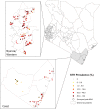Factors associated with the performance and cost-effectiveness of using lymphatic filariasis transmission assessment surveys for monitoring soil-transmitted helminths: a case study in Kenya
- PMID: 25487730
- PMCID: PMC4347340
- DOI: 10.4269/ajtmh.14-0435
Factors associated with the performance and cost-effectiveness of using lymphatic filariasis transmission assessment surveys for monitoring soil-transmitted helminths: a case study in Kenya
Abstract
Transmission assessment surveys (TAS) for lymphatic filariasis have been proposed as a platform to assess the impact of mass drug administration (MDA) on soil-transmitted helminths (STHs). This study used computer simulation and field data from pre- and post-MDA settings across Kenya to evaluate the performance and cost-effectiveness of the TAS design for STH assessment compared with alternative survey designs. Variations in the TAS design and different sample sizes and diagnostic methods were also evaluated. The district-level TAS design correctly classified more districts compared with standard STH designs in pre-MDA settings. Aggregating districts into larger evaluation units in a TAS design decreased performance, whereas age group sampled and sample size had minimal impact. The low diagnostic sensitivity of Kato-Katz and mini-FLOTAC methods was found to increase misclassification. We recommend using a district-level TAS among children 8-10 years of age to assess STH but suggest that key consideration is given to evaluation unit size.
© The American Society of Tropical Medicine and Hygiene.
Figures






Similar articles
-
A first nation-wide assessment of soil-transmitted helminthiasis in Fijian primary schools, and factors associated with the infection, using a lymphatic filariasis transmission assessment survey as surveillance platform.PLoS Negl Trop Dis. 2020 Sep 25;14(9):e0008511. doi: 10.1371/journal.pntd.0008511. eCollection 2020 Sep. PLoS Negl Trop Dis. 2020. PMID: 32976499 Free PMC article.
-
Factors associated with soil-transmitted helminths infection in Benin: Findings from the DeWorm3 study.PLoS Negl Trop Dis. 2021 Aug 17;15(8):e0009646. doi: 10.1371/journal.pntd.0009646. eCollection 2021 Aug. PLoS Negl Trop Dis. 2021. PMID: 34403424 Free PMC article. Clinical Trial.
-
Soil-transmitted helminths in pre-school-aged and school-aged children in an urban slum: a cross-sectional study of prevalence, distribution, and associated exposures.Am J Trop Med Hyg. 2014 Nov;91(5):1002-10. doi: 10.4269/ajtmh.14-0060. Epub 2014 Aug 25. Am J Trop Med Hyg. 2014. PMID: 25157123 Free PMC article.
-
Prevalence of soil-transmitted helminth infections, schistosomiasis, and lymphatic filariasis before and after preventive chemotherapy initiation in the Philippines: A systematic review and meta-analysis.PLoS Negl Trop Dis. 2021 Dec 20;15(12):e0010026. doi: 10.1371/journal.pntd.0010026. eCollection 2021 Dec. PLoS Negl Trop Dis. 2021. PMID: 34928944 Free PMC article.
-
A systematic review and meta-analysis of human and zoonotic dog soil-transmitted helminth infections in Australian Indigenous communities.PLoS Negl Trop Dis. 2022 Oct 24;16(10):e0010895. doi: 10.1371/journal.pntd.0010895. eCollection 2022 Oct. PLoS Negl Trop Dis. 2022. PMID: 36279298 Free PMC article.
Cited by
-
National mapping of soil-transmitted helminth and schistosome infections in Ethiopia.Parasit Vectors. 2020 Sep 1;13(1):437. doi: 10.1186/s13071-020-04317-6. Parasit Vectors. 2020. PMID: 32873333 Free PMC article.
-
Economic evaluations of lymphatic filariasis interventions: a systematic review and research needs.Parasit Vectors. 2018 Feb 1;11(1):75. doi: 10.1186/s13071-018-2616-z. Parasit Vectors. 2018. PMID: 29391042 Free PMC article.
-
Comparison of individual and pooled diagnostic examination strategies during the national mapping of soil-transmitted helminths and Schistosoma mansoni in Ethiopia.PLoS Negl Trop Dis. 2018 Sep 10;12(9):e0006723. doi: 10.1371/journal.pntd.0006723. eCollection 2018 Sep. PLoS Negl Trop Dis. 2018. PMID: 30199526 Free PMC article.
-
Short communication: Epidemiological assessment of Strongyloides stercoralis in Fijian children.Parasite Epidemiol Control. 2016 Sep 5;1(3):263-267. doi: 10.1016/j.parepi.2016.08.005. eCollection 2016 Sep. Parasite Epidemiol Control. 2016. PMID: 29988183 Free PMC article.
-
The Mini-FLOTAC technique for the diagnosis of helminth and protozoan infections in humans and animals.Nat Protoc. 2017 Sep;12(9):1723-1732. doi: 10.1038/nprot.2017.067. Epub 2017 Aug 3. Nat Protoc. 2017. PMID: 28771238
References
-
- World Health Organization . Helminth Control in School-Age Children: A Guide for Managers of Control Programmes. Geneva: World Health Organization; 2011.
-
- World Health Organization . Soil-Transmitted Helminthiasis: Eliminating Soil-Transmitted Helminthiasis as a Public Health Problem in Children. Geneva: World Health Organization; 2012.
-
- Solomon AW, Engels D, Bailey RL, Blake IM, Brooker S, Chen JX, Chen JH, Churcher TS, Drakeley CJ, Edwards T, Fenwick A, French M, Gabrielli AF, Grassly NC, Harding-Esch EM, Holland MJ, Koukounari A, Lammie PJ, Leslie J, Mabey DC, Rhajaoui M, Secor WE, Stothard JR, Wei H, Willingham AL, Zhou XN, Peeling RW. A diagnostics platform for the integrated mapping, monitoring, and surveillance of neglected tropical diseases: rationale and target product profiles. PLoS Negl Trop Dis. 2012;6:e1746. - PMC - PubMed
-
- World Health Organization . Monitoring and Epidemiological Assessment of Mass Drug Administration in the Global Programme to Eliminate Lymphatic Filariasis: A Manual for National Elimination Programmes. Geneva. World Health Organization; Global Program to Eliminate Lymphatic Filariasis: 2011.
Publication types
MeSH terms
Substances
Grants and funding
LinkOut - more resources
Full Text Sources
Other Literature Sources

